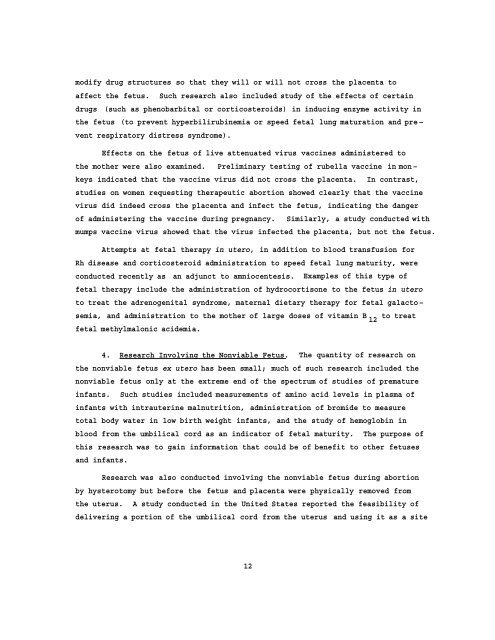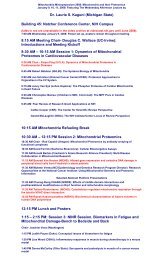RESEARCH ON THE FETUS - National Institutes of Health
RESEARCH ON THE FETUS - National Institutes of Health
RESEARCH ON THE FETUS - National Institutes of Health
You also want an ePaper? Increase the reach of your titles
YUMPU automatically turns print PDFs into web optimized ePapers that Google loves.
modify drug structures so that they will or will not cross the placenta to<br />
affect the fetus. Such research also included study <strong>of</strong> the effects <strong>of</strong> certain<br />
drugs (such as phenobarbital or corticosteroids) in inducing enzyme activity in<br />
the fetus (to prevent hyperbilirubinemia or speed fetal lung maturation and prevent<br />
respiratory distress syndrome).<br />
Effects on the fetus <strong>of</strong> live attenuated virus vaccines administered to<br />
the mother were also examined. Preliminary testing <strong>of</strong> rubella vaccine in monkeys<br />
indicated that the vaccine virus did not cross the placenta. In contrast,<br />
studies on women requesting therapeutic abortion showed clearly that the vaccine<br />
virus did indeed cross the placenta and infect the fetus, indicating the danger<br />
<strong>of</strong> administering the vaccine during pregnancy. Similarly, a study conducted with<br />
mumps vaccine virus showed that the virus infected the placenta, but not the fetus.<br />
Attempts at fetal therapy in utero, in addition to blood transfusion for<br />
Rh disease and corticosteroid administration to speed fetal lung maturity, were<br />
conducted recently as an adjunct to amniocentesis. Examples <strong>of</strong> this type <strong>of</strong><br />
fetal therapy include the administration <strong>of</strong> hydrocortisone to the fetus in utero<br />
to treat the adrenogenital syndrome, maternal dietary therapy for fetal galactosemia,<br />
and administration to the mother <strong>of</strong> large doses <strong>of</strong> vitamin B 12<br />
to treat<br />
fetal methylmalonic acidemia.<br />
4. Research Involving the Nonviable Fetus. The quantity <strong>of</strong> research on<br />
the nonviable fetus ex utero has been small; much <strong>of</strong> such research included the<br />
nonviable fetus only at the extreme end <strong>of</strong> the spectrum <strong>of</strong> studies <strong>of</strong> premature<br />
infants. Such studies included measurements <strong>of</strong> amino acid levels in plasma <strong>of</strong><br />
infants with intrauterine malnutrition, administration <strong>of</strong> bromide to measure<br />
total body water in low birth weight infants, and the study <strong>of</strong> hemoglobin in<br />
blood from the umbilical cord as an indicator <strong>of</strong> fetal maturity. The purpose <strong>of</strong><br />
this research was to gain information that could be <strong>of</strong> benefit to other fetuses<br />
and infants.<br />
Research was also conducted involving the nonviable fetus during abortion<br />
by hysterotomy but before the fetus and placenta were physically removed from<br />
the uterus. A study conducted in the United States reported the feasibility <strong>of</strong><br />
delivering a portion <strong>of</strong> the umbilical cord from the uterus and using it as a site<br />
12











